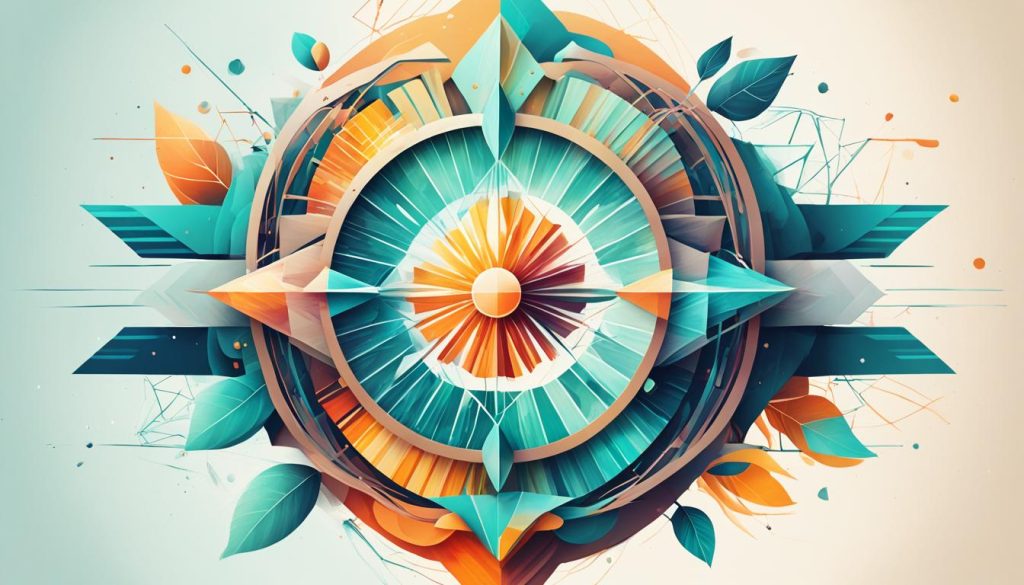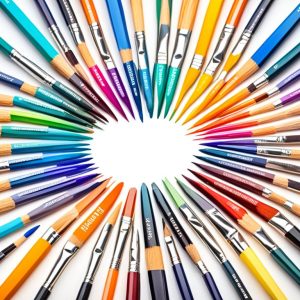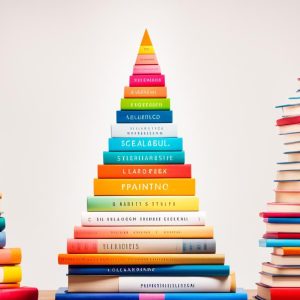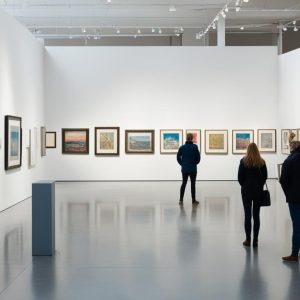As an artist and digital art enthusiast, I have always been captivated by the endless possibilities that digital art offers. From stunning digital illustrations to immersive digital paintings, the digital art world is a treasure trove of creativity and innovation.
In this article, we will delve into the different types and styles of digital artwork, shedding light on the popular forms that have captured the hearts of artists and art lovers alike. Whether you’re a seasoned digital artist or someone just starting to explore this exciting medium, join me on this journey as we uncover the diversity and beauty of digital art.
Key Takeaways:
- Digital art offers a wide range of artistic expression and possibilities.
- There are various types of digital art, including digital illustration and digital painting.
- Popular digital art styles include anime, caricature, cartoon, and realism.
- Contemporary digital art trends push the boundaries and incorporate technology.
- Digital art encompasses different roles and careers within the industry.
Digital Illustration Styles
Digital illustration is a versatile form of digital art that can be used in various industries, including advertising, video games, books, and social media. It combines traditional drawing techniques with digital tools to create captivating visuals. In this section, we will explore popular digital illustration styles that offer unique aesthetics and techniques for creating digital illustrations.
Anime: Anime style is characterized by its vibrant colors, exaggerated features, and captivating storytelling. It is widely popular in Japanese animation and has influenced the global animation industry.
Caricature: Caricature style focuses on exaggerating the distinctive features or characteristics of a subject to create a humorous or satirical representation. It is often used in editorial cartoons and portraits.
Cartoon: Cartoon style is known for its simplified forms, bold outlines, and humorous themes. It is commonly used in comics, children’s illustrations, and animated films.
Children’s Illustration: Children’s illustration style employs whimsical and colorful visuals to appeal to young audiences. It often combines elements of storytelling and imagination.
Comics: Comics style utilizes sequential art and panels to tell a story. It ranges from superhero comics to independent graphic novels, each with its own unique art style.
Commercial Illustration: Commercial illustration style focuses on creating visuals to support marketing and advertising campaigns. It can include product illustrations, promotional artwork, and brand mascots.
Concept Art: Concept art style is primarily used in the pre-production stages of video games, movies, and animations. It visualizes ideas, characters, and environments to guide the overall creative direction.
Fantasy Art: Fantasy art style explores imaginative and fantastical themes. It often features mythical creatures, epic landscapes, and magical elements to transport viewers to otherworldly realms.
Fashion Illustration: Fashion illustration style showcases clothing designs and trends. It plays a crucial role in the fashion industry, helping designers visualize their creations and communicate their vision.
Fine Art: Fine art style encompasses various artistic techniques and styles and is often created for aesthetic or intellectual purposes. It includes genres such as realism, abstract, impressionism, and surrealism.
Line Art: Line art style focuses on using lines to create intricate and detailed illustrations. It often uses various line weights and hatching techniques to add depth and dimension.
Realism: Realism style aims to recreate subjects with high accuracy, resembling real-life objects or people. It requires attention to detail, texture, light, and shading to achieve a lifelike representation.
Retro Art: Retro art style draws inspiration from past eras, incorporating vintage aesthetics and nostalgia into illustrations. It often uses vibrant colors, bold typography, and iconic design elements from specific time periods.
These are just a few examples of the diverse digital illustration styles available, each offering its own unique visual language and storytelling approach. Digital artists can experiment with different styles to find their own artistic voice and create captivating illustrations for various purposes.
Digital Painting Techniques
When it comes to digital art, digital painting is a popular form that enables artists to create stunning artworks using digital tools and software. This technique offers endless possibilities for creativity and expression. Let’s explore some of the different digital painting techniques and mediums that artists can utilize to bring their visions to life.
Photo Painting
One technique that digital artists often employ is photo painting, where they use existing photos as a base and paint over them digitally. This technique allows artists to incorporate the realistic details of photographs into their paintings while adding their unique artistic touch.
2D Digital Painting
2D digital painting involves creating digital artworks on a flat surface digitally. Artists use digital painting software and tools, such as Photoshop and Corel Painter, to simulate traditional painting techniques like brushstrokes and textures. This technique offers the flexibility to experiment with various styles and effects.
3D Digital Painting and Sculpting
In 3D digital painting and sculpting, artists use specialized software like ZBrush and Mudbox to create three-dimensional digital models and sculptures. They can then paint directly on these models, adding intricate details and textures. This technique is commonly used in the creation of characters and environments for movies, video games, and animations.
Pixel Art
Pixel art is a retro-style digital painting technique that involves creating artworks on a pixel grid. Artists meticulously place individual pixels to form images with limited color palettes. This technique is often associated with video games and nostalgic aesthetics, evoking a sense of nostalgia and simplicity.
Vector Art
Vector art involves creating digital illustrations using mathematical functions and geometrical shapes. Unlike raster-based art (which consists of pixels), vector art is resolution-independent, allowing artists to scale their artwork without losing quality. This technique is commonly used in graphic design, logos, and illustrations.
Raster Painting
Raster painting is a technique that involves creating digital paintings using raster-based software like Photoshop. Artists use brushes, layers, and various digital brushes to add depth, texture, and shading to their artwork. This technique allows for a wide range of styles, from realistic to abstract.
These are just a few examples of the many digital painting techniques and mediums available to artists. Each technique offers its own unique approach to creating digital paintings, allowing artists to explore their creativity and bring their ideas to life using digital tools and software.
Contemporary Digital Art Trends
The world of digital art is constantly evolving, and it’s fascinating to witness the contemporary trends and genres that are shaping the digital art landscape today. These trends are driving innovation, pushing the boundaries of traditional art, and creating new and exciting forms of digital art.
One of the contemporary digital art trends is abstract digital art. This genre explores the use of shapes, colors, and textures to evoke emotions and thoughts, often challenging conventional representations. It allows artists to experiment and create artwork that is open to interpretation, inviting viewers to engage with the visuals in a deeper, more personal way.

Data-moshing is another emerging trend in digital art. It involves intentionally manipulating digital data to create visual and auditory glitches, giving the artwork an intentionally distorted and fragmented look. This technique challenges the idea of perfection in art and explores the aesthetic appeal of imperfections and errors.
“Art is the lie that enables us to realize the truth.” – Pablo Picasso
Algorithmic art is gaining popularity among digital artists. It involves using mathematical algorithms and rules to generate artwork. Artists can create intricate patterns and designs that would be impossible to achieve manually. This genre opens up new creative possibilities and allows artists to collaborate with technology to produce unique and mesmerizing art pieces.
Integrated art is a trend that blurs the boundaries between art and technology. It involves the incorporation of digital elements into physical spaces, creating immersive and interactive experiences. From augmented reality installations to interactive sculptures, integrated art combines different mediums and creates a dynamic, multidimensional art form.
VR painting
Another trend making waves in the digital art world is VR painting. Virtual reality technology allows artists to step into a virtual world where they can create three-dimensional artworks using digital brushes and tools. It offers a unique and immersive experience, allowing artists to explore new perspectives and dimensions in their artwork.
- Projection mapping is an innovative technique used by digital artists to transform ordinary objects, such as buildings and sculptures, into dynamic and animated displays. By mapping digital images or videos onto physical surfaces, artists can create mesmerizing visual experiences that challenge spatial perception.
- AI art is an exciting frontier in the digital art world. Artists are experimenting with artificial intelligence algorithms to generate artwork autonomously or in collaboration with AI systems. This genre explores the relationship between humans and machines, raising questions about creativity, authorship, and the boundaries of art.
As we witness the evolution of digital art, these contemporary trends and genres continue to shape the way we perceive and engage with art. They push the boundaries of traditional art forms, challenge established norms, and create new and innovative digital art mediums.
Different Types of Digital Artists
Digital art is a vast and diverse field that encompasses various roles and careers. From concept artists to graphic designers, there are numerous types of digital artists, each specializing in a unique area of expertise. Let’s explore some of the common digital artist roles and the skills they require:
1. Concept Artists
Concept artists are responsible for creating visual representations of ideas, characters, and environments. They work closely with art directors and clients to develop the initial concept and set the creative direction for projects.
2. Illustrators
Illustrators use their artistic skills to create visual interpretations of ideas, stories, or concepts. They often work in industries such as publishing, advertising, and gaming, bringing written content to life through captivating visuals.
3. Character Artists
Character artists specialize in designing and creating digital characters for various media, including animation, video games, and film. They focus on character development, from initial sketches to detailed digital renderings.
4. Environment Artists
Environment artists are responsible for creating digital landscapes, backgrounds, and settings. They collaborate with game developers, filmmakers, and architects to design immersive and realistic environments.
5. Animators
Animators bring static digital assets to life through movement. They use various software and techniques to create smooth and engaging animations in industries such as entertainment, advertising, and education.
6. 3D Modelers
3D modelers specialize in creating three-dimensional digital models using software such as Maya or Blender. They often work in the gaming, film, and advertising industries, bringing virtual objects and characters to life.
7. Graphic Designers
Graphic designers use their creativity and technical skills to create visually appealing digital designs for branding, marketing, and communication purposes. They work with typography, color theory, and layout to convey messages effectively.
8. VFX Artists
VFX artists create digital effects for films, TV shows, and advertisements. They use software such as Adobe After Effects and Maya to create realistic visual effects like explosions, CGI creatures, and supernatural phenomena.
9. UI/UX Designers
UI/UX designers focus on creating intuitive and user-friendly interfaces for websites, apps, and software. They combine visual design with user research to enhance the user experience and improve usability.
10. Storyboard Artists
Storyboard artists play a crucial role in visual storytelling. They illustrate and sequence key moments of a narrative, providing a visual blueprint for directors, animators, and other team members.
11. Matte Painters
Matte painters create digital backgrounds and environments for films and animations. They use their artistic skills to seamlessly blend real and digital elements, enhancing the visual aesthetics of the project.
Each digital artist role requires specific skills and expertise to excel in the industry. As technology continues to advance, the demand for digital artists with diverse talents will continue to grow. Whether you’re interested in concept art, animation, or graphic design, pursuing a career as a digital artist offers a world of creativity and possibilities.

Conclusion
In conclusion, digital art opens up a world of possibilities for artistic expression. With numerous types and styles, artists can explore their creativity in various ways. From digital illustration to digital painting, there is a diverse range of mediums and techniques to suit every artist’s preference.
Contemporary digital art trends continually push the boundaries of traditional art, introducing innovative concepts and technologies. Artists can experiment with abstract digital art, data-moshing, algorithmic art, VR painting, and more. These trends redefine what is possible in the digital art world, inspiring artists to embrace new forms of creativity.
Moreover, the digital art community is enriched by different types of digital artists, each bringing their unique skills and expertise. From concept artists to 3D modelers, animators to graphic designers, there are numerous career paths within the digital art industry. The collaboration and diversity among digital artists contribute to the growth and evolution of the field as a whole.
Whether you are a seasoned artist or just beginning your journey, exploring the world of digital art can be an exciting and rewarding experience. With an abundance of options, styles, and trends to choose from, digital art offers endless opportunities for personal expression and growth.
FAQ
What are the different types and styles of digital art?
What are some popular digital illustration styles?
What techniques are used in digital painting?
Are there any contemporary trends in digital art?
What are the different types of digital artists?
Share this content:






